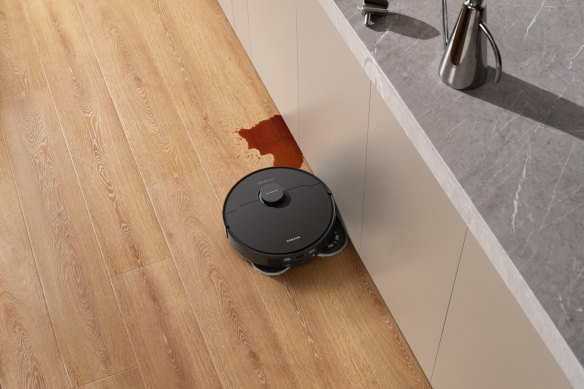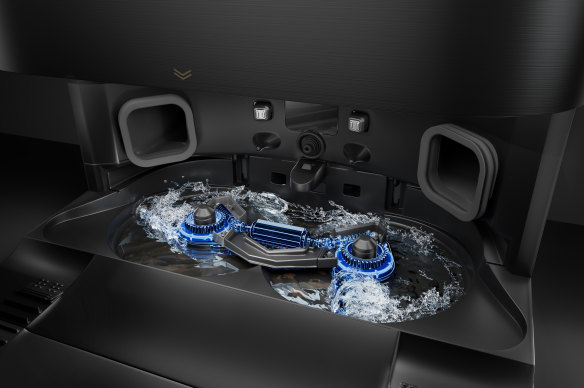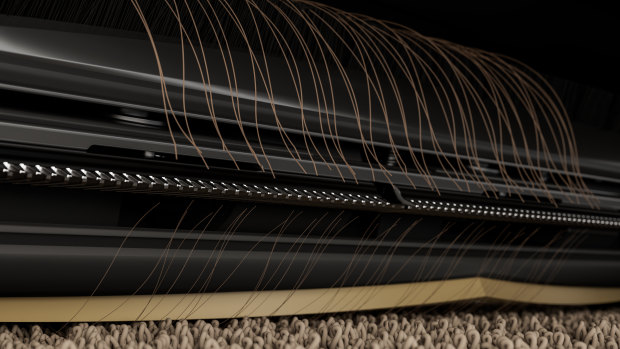Why robot vacuums still have plenty of tricks to learn
By Tim Biggs
Despite being around for decades, robot vacuums are still constantly introducing new features that make them more capable of cleaning your floors autonomously. While many of the new capabilities tend to appear at the high end on remarkably expensive machines, the innovations do tend to flow down to less expensive models within a few years.
Like many robot vacuums, the new X40 Ultra from Chinese company Dreame is designed to be mostly set-and-forget. With a Lidar scanner, camera, and headlamp, it maps a home quickly and has no problem manoeuvring around without bumping into things. It also has a powerful vacuum, a pair of mopping pads, and a home base that lets it charge, empty dirt into a bag, store dirty water, and top up on fresh water.

The Dreamebot X40 Ultra can reach its mop pad under obstacles.
However, the $2700 X40 Ultra also has a few new tricks to address some lingering robo-vac issues.
Wet mop pads and dirty water tend to make the home bases dank and smelly after a while, meaning manual cleaning of the home base is required often with many of these robots but far less often with the X40 Ultra. The system washes its own mop pads, analysing the colour of the water to ensure it’s clean while also cleansing its own washboard. Then, it uses hot air to dry.
You still have to empty the old water tank and fill up the fresh, but other than that, you largely don’t need to do anything.
The robot is also surprisingly dextrous, able to hold out its right-side mop pad to reach under cupboard doors or the fridge. It can also lift its rotor brush to avoid flicking liquid spills, which it consistently detects and mops up. It’s very satisfying to see it detect a dirty patch and rotate around it while buffing.
The device can technically lift its mop pads entirely to switch from hard floors to carpet, but it doesn’t lift them very high, which is a rare strike against the Dreamebot versus the less expensive Roomba Combos and their hinged mop pads. Thankfully, you can use the app to define floor materials, which makes sure the robot plans a route that won’t get your carpet wet. It deposits its mop pads at the dock when it doesn’t need them.

A washboard that rinses and cleans itself is a big upgrade to the home base.
The X40 Ultra has a home base that is much narrower and easier to fit in a space compared to previous Dreamebots. It also replaces the proprietary cleaning solution bottle with a standard refillable one, which is a big improvement, but only because the previous design wasn’t great.
Anybody who has used a robot vacuum will also know how annoying long human hairs can be; they hide in the carpet in surprising volume and strangle the device’s rollers, sometimes causing permanent damage, until you cut them off. Dreame has a solution for this, too – if you are happy to pay $200 extra for its TriCut roller brush. This metal-toothed rod shreds any hair it collects and feeds it to the vacuum, and it’s as effective as it is vicious-looking.

The TriCut brush works like a set of clippers to eliminate tangled hair.
All of this, combined with standard robo-vac features, such as voice assistant support, brings the X40 Ultra a step closer to the dream of a seamless floor-cleaning helper that gets its work done on its own while you are out of the house. Of course, despite all the progress, there are still many common issues left for the robot vacuum to surmount.
Stairs are an obvious challenge for anyone who wants a robot to clean their floors seamlessly across multiple storeys. None of the major manufacturers is even close to designing a robot vacuum that can climb, and, to be honest, it would probably be so bulky, expensive, and inconvenient that getting a separate robot for each floor (or just carrying it now and then) would work out better anyway.
The main annoyance is the continued need to vacuum the stairs manually. That’s not to say a climbing robot will never happen, and there is clearly a demand. Migo Robotics made headlines last year and attracted millions of dollars in Kickstarter pledges for its stair-climbing Ascender robot, which was due to be released this month. However, in May, the company admitted the robot was not ready and refunded the pledges.
Even with the most advanced robots, I have faced some perplexing challenges. Like many robotic or computerised products, some of it comes down to a lack of interpretability; the device is designed to make decisions on its own, but if, for some reason, it decides never to vacuum one of your rooms or refuses to release water for its mop, you have no clue as to why. However, some of the issues are more low-tech.
One Roomba we tested developed a mite infestation that persisted no matter how much we cleaned it; tiny little white-speck creatures would reappear all over it within a few hours. With so many places for them to hide in both the robot and the home base, filters, and dust bags, we ended up having to disassemble it and replace the consumable bits to sort it out.
A particularly annoying issue in our rental is that the carpeted lounge room – which sits between a tiled kitchen and the entryway – has sunken by around four centimetres, and no robot I’ve tested that goes in there can get out. This has effectively cut the house into three distinct sections as far as robots are concerned, even though it’s all a single level, meaning you’d either need to carry the device to different spots or buy three robots. We’ve tried building little ramps for them to travel up, but training a robot to use them has proven impossible.
Finally, no matter how smart vacuum robots get (the Dreamebot will take photos of shoes and send them to me, as if to say, “Put your shoes away next time if you want me to vac here”), they still inevitably suck up things they’re not supposed to.
If you have vertical blinds with beads connecting them at the bottom, the robot will obliterate them. I’ve also pulled out Pokemon cards the kids dropped under the couch, pages of paper that fell off the fridge, mangled cable ties, cat toys that may have been planted in an attempt to fell the robot, and much more.
It remains the responsibility of the human operator to make sure the floors are clear and, in most cases, you hear something amiss with the robot and pull the object out unscathed. Indeed, we’ve only had one really dangerous incident. A USB cable was left on the floor while it was still plugged in; the robot broke it and then continued on its way. The cable plug then became incredibly hot, burning my son when he tried to use it. Not the robot’s fault – but it would be nice if it was as vigilant about cables as it is about shoes!
Get news and reviews on technology, gadgets and gaming in our Technology newsletter every Friday. Sign up here.